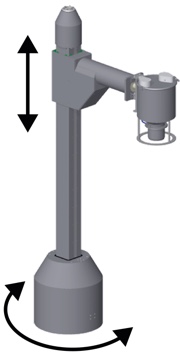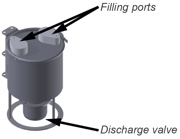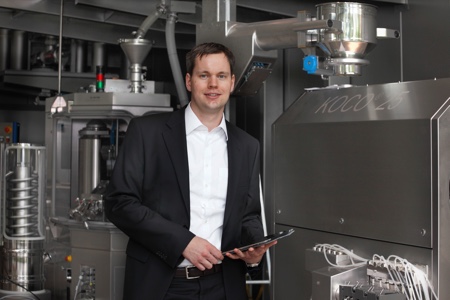During ACHEMA 2015, L.B. Bohle presented the ROB 50 as an innovative solution to automate and optimise production processes in both continuous and batch-oriented production of solid dosage forms. The ROB 50 is a robotic system for handling of tablet containers, to close the gap between the tablet press and film coating process.
Initially, L.B. Bohle developed the ROB 50 for the Continuous Production Line (by the consortium of Gericke AG, Korsch AG and L.B. Bohle), installed in the Technology Centre in Ennigerloh, Germany. In general, it is desirable to maintain a continuous material flow through the production line from the initial dispensing of raw materials, up to the film coating of the final tablets. However, if the tablet cores after compression are immediately transferred into the coating process, the expansion behaviours of tablet cores implies an imminent risk for cracks/fissures in the film coating.
The film coating layer behaves like a rigid shell around the core, with the expanding core applying forces pointing outwards (see Figure 1). Due to the insufficient elasticity of this shell, these forces lead to cracks at the weakest points of the coating layer. Obviously, such defects are unacceptable quality deficiencies, and in the case of functional coatings also affect the therapeutic effect of the pharmaceutical product.

Figure 2: By ensuring a sufficient tablet relaxation time, the core can expand before applying the film coat
To overcome this problem, a tablet core relaxation time is required between the tablet compression process and the film coating process, as indicated in Figure 2. The required tablet core relaxation time is product dependent and can reach from a few minutes to several hours.
In batch production, the workflow for approval of the tablet cores as intermediate product already provides sufficient time for the tablet cores to expand. However, the concept of continuous production aims to eliminate product movement between the production area and warehouse in order to facilitate an increased turnover time, ideally with real time release mechanisms.
This motivation led to the development and implementation of the ROB 50 as an automated handling system for tablet cores, illustrated in Figure 3. The central part of this unit is the robotic lifting column with an elongated arm, required to move tablet containers between different positions. With the two degrees of freedom (rotation and lifting, see Figure 4) the system is able to position the cradle at the tip of the arm on a cylindrical operation range around the robot. Using the cradle, the robot can pick up tablet containers (Figure 5) automatically.

Figure 3: Overview of the ROB 50 setup
These tablet containers feature a lid with filling ports, as well as a discharge valve at the bottom. When picking up a container, the robot also establishes a control connection in order to operate the discharge valve.
Within the robot’s operation range, it can reach the following three locations:
- Filling position
- Storage rack
- Discharge position into film coater

Figure 4 (above) and Figure 5 (below): The ROB 50 features two degrees of freedom (Figure 4) to pickup the containers (Figure 5) with integrated filling and discharge ports

The filling position (1) with two container pitches is located at the outlet of the tablet de-duster of the tablet press. A diverter valve at the outlet of the de-duster directs the tablet stream into one of the two containers in place. Whenever the currently active container is full, the diverter switches the tablet stream over into the container in the other pitch.
Now, the robot can pick up the full container and replace it with an empty one. The container storage rack (2) holds the tablet containers during the relaxation time, as well as empty containers to be re-used at the filling position. The size of the storage rack is to be calculated based on the production parameters, specifically the throughput of the tablet press and coater, to realise the required tablet core relaxation time.
Finally, the third position is the discharge position into the film coater (3). By positioning a full container above the inlet into the coating process and opening the discharge valve at the bottom of the container, the tablet cores are released into the process. Ideally, the coater supports a charging from the top, such as the Bohle KOCO product series.
Certainly, the benefit of the ROB 50 lies in the automation of these transport processes. The integrated control software features an inventory system for all containers and pitches. By interfacing with both the tablet press and the tablet coater, the control unit schedules the different transport jobs and optimises the material flow based on predefined priorities. This not only ensures an optimal execution plan, but also a compliance with the predefined relaxation times, critical for the product quality.

Dr Hubertus Rehbaum, Manager Scientific Operations, developed the process control together with his team
As indicated initially, L.B. Bohle developed this system for the continuous production line. However, the ROB 50 can also automate the product transfers in batch environment, to close the gap between tablet press and film coater. In this case, the ROB 50 is also available for larger container sizes.
In addition, in case of long process times for the film coating process, the ROB 50 can servive two coaters positioned next to each other in an alternating manner. Customised versions with an additional degree of freedom are available, too. For higher throughput or long relaxation times, L.B. Bohle also has solutions to automate the storage rack.
In summary, L.B. Bohle offers with the ROB 50 an innovative solution to decrease the lead-time of film-coated tablets, while reducing costs for product handling and risks for failures in the production workflow.

